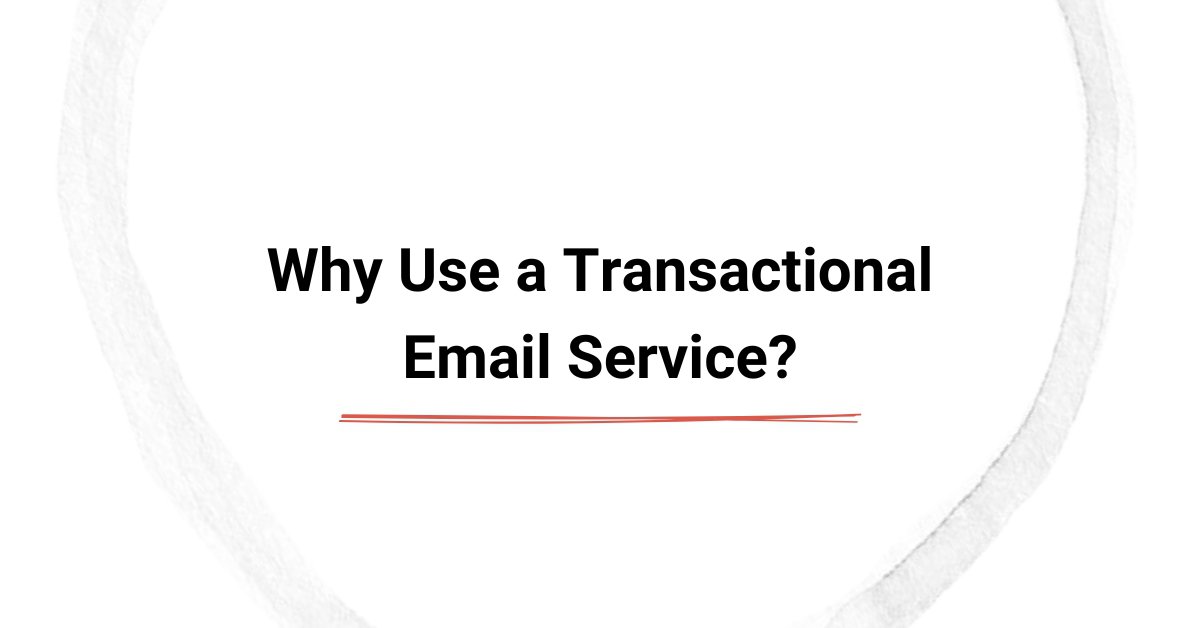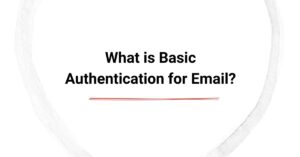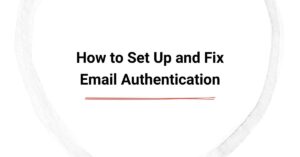When you’re setting out to improve your overall customer interaction, you may be asking, “Why use a transactional email service?” The answer is quite simple. Transactional emails are for business operations and work better than traditional email servers. Traditional routes can lead to deliverability issues, delays, and security risks. When this happens, your customer’s data may be at risk. With this in mind, the better option would be to switch to transactional emails.
Our article takes a look at what transactional emails are and also covers the top benefits of using this email service. We highlight the key steps needed to choose the best one for your unique business needs. We also provide insights into how these services compare to traditional email systems and how businesses can choose the right provider.
Here’s a quick overview of what you need to know about transactional emails:
- Transactional email services improve deliverability and inbox placement.
- They ensure emails are sent quickly and reliably, even at high volumes.
- They offer built-in authentication tools (SPF, DKIM, DMARC) to prevent spam filtering.
- Using an API-based service allows for better email automation and tracking.
- They help businesses comply with the GDPR, CAN-SPAM, and other regulations.
What is a Transactional Email Service?
A transactional email service is a dedicated platform or provider that automates and ensures the reliable delivery of transactional emails containing essential information such as order confirmations, password resets, and account notifications. Essentially, this means you are sending your customers emails based on their interaction on your website, app, or other digital avenues of your business.
Key features of an automated email service can be listed as:
- Higher email deliverability rates;
- Real-time email tracking and analytics;
- API & SMTP integration for seamless sending;
- Total compliance with email regulations.
Why Use a Transactional Email Provider? (Top Benefits)
There are several excellent reasons why a transactional email service is beneficial for many businesses, their customers, and even their budgets. Below, we’ve listed the most significant benefits.
1. Improved Email Deliverability
When it comes to improving email deliverability, it’s important to understand why regular email servers don’t work as effectively. Emails can end up in the spam folder due to the lack of authentication settings in traditional email services. Therefore, sending transactional emails from standard platforms such as Gmail and Outlook risks deliverability issues.
On the other hand, transactional email services provide optimized sending IP and domain reputation, ensuring better deliverability and higher inbox placement. In addition, their built-in ESP reputation management actively works to prevent domain blacklisting.
2. Faster and More Reliable Email Delivery
Transactional email delivery is faster and more reliable with lower bounce rates. Cloud-based email infrastructure can process thousands of emails per second. This guarantees real-time email dispatch even during peak hours. On the contrary, mails can be delayed during high-traffic periods with in-house email servers. Some providers also rate-limit outgoing emails, which causes further delays.
3. API-Based Email Sending for Seamless Automation
Transactional emails allow for seamless automation. This means custom workflows can redirect specific email content to customers based on their recent activity, creating a more personalized approach. So, a customer who abandoned their cart will get a different email than one who is changing their password after not visiting the page for a while.
Another significant advantage of using an email API over an SMTP service is the enhanced speed and tracking capabilities. With APIs, email processing is faster, ensuring timely delivery of messages. Additionally, email APIs enable detailed analytics, providing valuable insights into email performance, such as open rates, click-through rates, and bounce statistics.
4. Better Email Security and Authentication
Transactional emailing offers better security thanks to TLS encryption for data security, providing protection against email spoofing and phishing attacks. Moreover, emails are more likely to be flagged as spam without proper authentication. A transactional email sending infrastructure comes with built-in SPF, DKIM, and DMARC authentication features.
5. Compliance with Email Regulations (GDPR, CAN-SPAM, CASL)
Sending transactional emails incorrectly can violate global data privacy laws, including the GDPR, CAN-SPAM, and CASL. Furthermore, you have to be extra careful with receivers' unsubscribe preferences. These actions can lead to serious fines for your business.
To avoid these issues, transactional email services are all compliant with local laws that govern customer data and security. They also auto-handle unsubscribe requests for marketing messages and provide detailed audit trails for email tracking.
6. Cost-Effectiveness for High-Volume Sending
Cost saving is an effective part of any business, and you’ll want a bulk email solution that not only saves your company money but is also secure to send via email.
Self-managed email servers often lead to quite high operational expenses for maintaining the in-house infrastructure. For instance, they require dedicated IT resources to manage email queues and blacklists.
When it comes to the cost-effectiveness of high-volume sending, transactional emails are much cheaper to send in bulk. Pay-as-you-go pricing models are typically offered by services like SendGrid and Amazon SES. This prevents wasted costs on undelivered emails.
Key Features to Look for in a Transactional Email Service
When you’re looking for the best transactional email service, it’s essential to check for specific features that will enhance your overall experience. Typically, you'll need a service offering seamless authentication, improved deliverability, real-time analytics, API support, and full compliance with legal regulations.
1. High Deliverability Rates & IP Reputation Management
Providers must offer IP warm-up services for new senders and include reputation monitoring tools to track bounce and spam complaint rates.
2. Real-Time Email Tracking and Analytics
Tracking should include open rate, click-through rate (CTR), bounce tracking, and response time. The best services also provide dashboards with performance metrics.
3. API and SMTP Service Support
API-based sending is preferred for scalability and automation, while SMTP support remains necessary for legacy applications.
4. Built-in Authentication Tools (SPF, DKIM, DMARC)
These tools ensure emails are properly authenticated to prevent spoofing and help reduce the risk of emails being marked as spam.
5. Compliance with Email Regulations
Lastly, providers must support opt-in/opt-out management for marketing emails and maintain logs to provide legal audit trails.
Best Transactional Email Services to Consider
There are a few top options well worth adding to your shortlist. It’s also not uncommon for companies to use more than one, depending on their varied needs.
1. SendGrid
SendGrid is ideal for businesses that need a highly scalable, API-driven email solution with strong developer support. Its powerful APIs make it easy to automate transactional emails, and it offers detailed analytics to monitor performance at scale.
2. Postmark
Postmark is known for its lightning-fast delivery speeds and rock-solid reliability, making it perfect for time-sensitive transactional emails. It prioritizes transactional traffic over marketing emails, so your critical messages arrive quickly and consistently.
3. Amazon SES
Amazon SES is a great choice for businesses that need a budget-friendly solution for sending large volumes of emails. Its flexible pricing and seamless AWS integration make it ideal for scaling email operations without high overhead costs.
4. Mailgun
Mailgun is built with developers in mind, offering advanced customization, robust APIs, and powerful routing features for tailored email workflows. It's an excellent choice for teams that need full control over their transactional email setup.
5. Mailchimp’s Mandrill
Mandrill is a transactional email add-on for Mailchimp users, making it a seamless choice for those already using Mailchimp’s platform. It’s ideal for integrating marketing and transactional emails within a unified ecosystem.
Common Mistakes to Avoid When Using a Transactional Email Service
When sending out transactional emails, it’s essential to avoid the common mistakes that first-time users often make. Avoiding these mistakes will go a long way toward ensuring that your customers can trust your emails.
Using a Shared IP Without Warm-Up
Shared IPs can be affected by other users’ unsafe practices. Therefore, we recommend using a dedicated IP for high-volume sending.
Ignoring Email Authentication (SPF, DKIM, DMARC)
Improper authentication can lead to higher spam placement and security risks, so it's crucial to set up authentication properly.
Not Monitoring Bounce & Spam Complaint Rates
A high bounce rate can damage your domain reputation, so it's important to regularly clean your email list and suppress bounces.
Making the Switch to Smarter Email Delivery
It's essential to use transactional emails for many reasons, including reliable delivery, enhanced security, and total compliance with regulations. API-based services add scalability, automation, and tracking capabilities. Ultimately, choosing the right provider depends on your volume needs, budget, integration requirements, and overall business plan.
If you want to improve your transactional email strategy, feel free to get a free email audit today!









